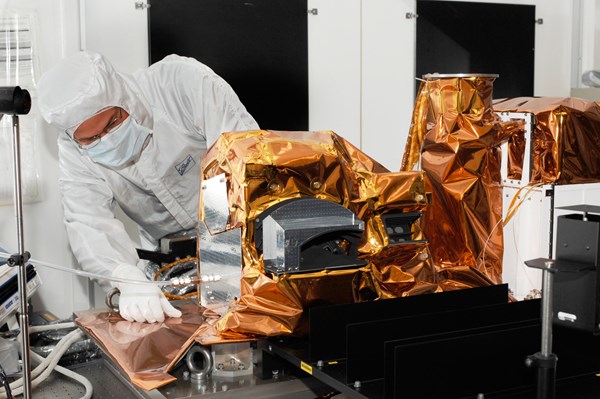REDONDO BEACH, Calif., Nov. 17, 2008 (GLOBE NEWSWIRE) -- Northrop Grumman Corporation (NYSE:NOC) announced that the third sensor of five has been delivered to NASA for integration onto the National Polar-orbiting Operational Environmental Satellite System (NPOESS) Preparatory Project (NPP) spacecraft. The science instrument will monitor ozone from space with higher fidelity than existing instruments.
A photo accompanying this release is available at http://media.primezone.com/noc/
The Advanced Technology Microwave Sounder, delivered by Northrop Grumman in 2005, was the first science instrument delivered to NPP.
Ozone in the atmosphere keeps the Sun's ultraviolet radiation from striking the Earth. The Ozone Mapping and Profiler Suite (OMPS) will measure the concentration of ozone in the atmosphere, providing information on how ozone concentration varies with altitude. Data from OMPS will continue three decades of climate measurements of this important parameter used in global climate models. The OMPS measurements also fulfill the U.S. treaty obligation to monitor global ozone concentrations with no gaps in coverage.
Northrop Grumman, the prime contractor for NPOESS, has the responsibility for overseeing the development of sensors for NPP; Ball Aerospace & Technologies Corporation (NYSE:BLL) built the instrument and is integrating the NPP spacecraft for NASA Goddard Space Flight Center. NPOESS is being developed for the NPOESS Integrated Program Office as the next generation low-Earth orbiting operational environmental system.
"OMPS delivery represents a major step forward for this important program," said Dave Vandervoet, vice president of Civil Systems Division for Northrop Grumman's Space Technology sector. "Following on the recent CERES delivery, and with the upcoming Cross-track Infrared Sounder delivery, the NPP spacecraft will have flight unit instruments to integrate, enabling the program to take the next important step into system integration and test on the path to launch."
"Ball's next generation OMPS instrument is designed to significantly outperform its predecessors," said Cary Ludtke, vice president and general manager of Civil and Operational Space for Ball Aerospace & Technologies Corporation. "From SAGE III to SBUV/2 and now OMPS, Ball's ozone monitoring sensors continue to advance atmospheric science research."
OMPS is comprised of two sensors, a nadir sensor and limb sensor. Measurements from the nadir sensor are used to generate total column ozone measurements, while measurements from the limb sensor generate ozone profiles of the along-track limb scattered solar radiance.
Production of the OMPS Flight Model 2 (FM2) instrument for the first NPOESS spacecraft designated as C1 is also well underway. All three major components of the FM2 Nadir sensor are complete and in component level testing. Production of printed wiring boards for the FM2 Main Electronics Box is approximately 50% complete. The OMPS FM2 delivery is scheduled for Dec. 2010, in preparation for the NPOESS C1 launch scheduled for 2013.
The NPP mission is a joint effort between NASA and the NPOESS Integrated Program Office to bridge long-term climate data measurements between research satellites and operational systems -- as well as to reduce risk in preparing for NPOESS to go operational.
Ball Aerospace & Technologies Corporation supports critical missions of important national agencies such as the Department of Defense, NASA, NOAA and other U.S. government and commercial entities. The company develops and manufactures spacecraft, advanced instruments and sensors, components, data exploitation systems and RF solutions for strategic, tactical and scientific applications. Since 1956, Ball Aerospace has been responsible for numerous technological and scientific 'firsts' and acts as a technology innovator for the aerospace market.
Northrop Grumman Corporation is a global defense and technology company whose 120,000 employees provide innovative systems, products, and solutions in information and services, electronics, aerospace and shipbuilding to government and commercial customers worldwide.
Note to Editors
* The OMPS consists of a dual-redundant main electronics box and a modular 2-sensor design: a nadir viewing mapper and a limb viewing profiler. * Measurements from the Nadir sensor are used to generate total column ozone Environmental Data Records (EDRs), with better than 50 x 50 km resolution at nadir. The Limb sensor generates ozone profiles by measuring the along-track limb scattered solar radiance with 1 km vertical sampling. Both sensors will maintain long-term data product stability through periodic solar irradiance measurements. * OMPS data products will continue the global, daily data products similar to -- but with higher fidelity -- those from the Solar Backscatter Ultraviolet radiometer and the Total Ozone Mapping Spectrometer. It will also provide new, high vertical resolution limb profile data. * Sensor performance supports NPOESS environmental data record requirements with positive margin, with the highest performance margins at low ozone conditions to accurately monitor the severity and physical extent of the ozone hole * Operational algorithm development is well underway and will be complete and verified prior to NPP launch
